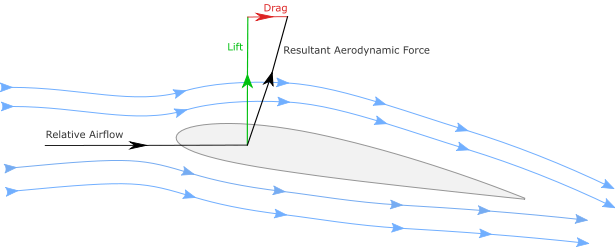Airfoil
Explanationedit
Airfoils are the characteristic shapes of any wings, propeller blades, compressor or turbine blades in an aircraft. This shape produces the aerodynamic force needed for an aircraft as it moves through the air at a certain angle, called angle of attack, by turning the incoming airflow downwards. This exerts an opposite aerodynamic force on the airfoil about its centre of pressure. The lift is the vertical component of this aerodynamic force to the direction of motion, and the drag is the horizontal component of it.
The airfoil shape is what makes the wings produce an efficient lift, by minimizing the drag. The lift produced by an airfoil can be explained by newton’s third law of motion and Bernoulli's principle. As the airfoil moves at a certain angle, it deflects the air downwards, producing an equal magnitude of force in the opposite direction, resolving to lift and drag respectively. In addition to this, the airfoil shape is responsible for pressure differences on the top and bottom of a wing. The upper surface of an airfoil has high-velocity air with a low potential energy and thereby less static pressure. Conversely, on the lower surface, there is a low-velocity region formed with increased static pressure. This pressure difference creates lift due to the Bernoulli's principle. However, the most significant effect is the force the air molecules exert on the airfoil.
Frequently Asked Questionsedit
What is stalling?edit
Stalling is a physical situation in a typical fixed-wing aircraft, where the wings will stop producing the required aerodynamic lift. This happens mostly when the angle of attack of an aircraft increases beyond the critical angle of attack, which is also called as the stalling angle of attack. Sometimes, a stall can happen when there is not enough airspeed for an aircraft to generate lift. Most stalls can be recovered by pitching the nose of the aircraft down, thereby reducing the angle of attack. However, in the case of deep stalls, a dangerous stall where a stalled wing pitches the plane up and masks any airflow to its tail section, the recovery will be hard as the elevators will not be able to help the pilot in pitching down the plane. As there is no lift produced by the wings during a stall, the altitude drops usually and it is always a crucial factor for a recovery maneuver.

